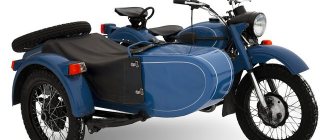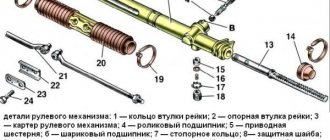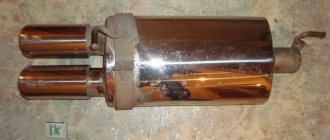The steering damper is an important element of the safety control of cars and motorcycles, most often found on the latter, but which can also be seen on SUVs. In particular, it is used on SUVs equipped with a solid front axle, prepared to overcome difficult terrain in areas where there are no roads. However, a steering damper can also be installed on passenger cars, for example, it is installed on the Lada Granta and some other passenger models.
What is a motorcycle steering damper used for?
Should I install a motorcycle steering damper or not?
This question comes up all the time among motorcycle fans. Often opinions on this matter differ. Because in this tuning it is not the quality of the damper that is considered important, but the quality of the motorcyclist himself. Based on the results of road tests of bikes, the stability of vehicles at high speed is constantly assessed. So, some motorcycles yaw, while others move as if on rails.
Stability of motor vehicles.
The bike constantly yaws, but the amount of this varies and depends on a number of factors:
- condition of the roadway;
- tire wear;
- speed;
- suspension geometry.
The wheel and front fork perfectly eliminate surface unevenness, but the vehicle suspension only works in the vertical plane. Therefore, if the motorcycle hits a bump, there will be a slight displacement of the wheel even in the horizontal plane. If you need MTF xenon, then you should visit the website www.autoglim.ru.
If the wheel of a motorcycle rotates strongly, then it has a gyroscopic effect, therefore, it tries to return to a neutral position corresponding to the tilt of the vehicle. However, while it is spinning, another bump may come across, and again the wheel will move a little. This is a normal process that occurs constantly when the vehicle is moving.
When a motorcycle rides on a flat surface, the motorcyclist does not feel all these vibrations: the impression of a straight ride is created. Of course, if the gyroscope does not return the wheel to a neutral position, then we cannot talk about any “hands-free” movement. It follows that, in principle, the motorcycle has stability, and it constantly tries to maintain a straight ride.
But it remains stable until someone tries to turn the steering wheel sharply. And while the bike has the correct weight distribution along the axes, the gyroscope puts up strong resistance when trying to change the position of the axle, which is what happens when the rider turns the handlebars.
The effect of the gyroscope increases with increasing speed of turning of the body, therefore, the higher the speed, the more difficult it is to turn the steering wheel of a motor vehicle. If you try to change the position of the gyroscope axis with a sharp movement, this will result in damped oscillations with a large deviation.
The situations that cause these vibrations vary, but usually they depend on the unloading of the front wheel. At such a moment, the danger of a sharp shift in the horizontal plane is especially likely.
Today, these problems are solved with the use of steering dampers. These are small devices that are similar in design to shock absorbers; they are able to dampen unnecessary vibrations of the fork. With the help of a steering damper, sharp vibration of the fork in the horizontal plane is removed. This device will also prevent these vibrations from forming.
Under typical conditions, a good motorcycle steering damper is unnoticeable and does not create any additional drag when riding. However, he is obliged, he is constantly ready, in order to remove strong hesitation at a crucial moment.
Basically, dampers need to be installed on modern sports bikes with their powerful engines that easily lift the bike onto the rear wheel with the rider, and small fork angles, as well as providing them with sharp handling. It goes without saying that the sharper the handling, the more the fork is affected by uneven road surfaces.
Of course, the device will not be able to completely damp out vibrations, but it can significantly reduce their amplitude and frequency. In this case, you don’t have to rely solely on the damper, because if the driver makes mistakes, for example, holding the steering wheel very tightly, then the bike will behave unstably and with the device.
Types of manual dampers.
Nowadays, two types of dampers are mainly in demand: telescopic and rotary. Telescopic devices resemble ordinary shock absorbers: a rod moves in the cylindrical body of the damper, on which a piston is fixed.
Installation of the device.
Telescopic dampers are installed in different ways. It all depends on the motorcycle model and mounting kit. Typically installed along the top brace of the fork. But there are different options, for example, fix the body on the frame and connect the rod using a lever with a fork or vice versa.
Rotor damper type.
Devices of this type are completely different from telescopic dampers. However, their operating principle is the same. This type of damper has a more durable design and excellent resistance to damage in an accident, so it is preferred to be used on off-road motor vehicles, and is also used on sport bikes.
The body of this device is often mounted on the upper cross member of the fork, and the moving axle is connected using a lever to the frame.
Features of the work.
The damper is a container filled with oil. It is divided by a movable partition into two chambers. There are also special valves, the size of which can be adjusted. A partition moves in the container, changing the volumes of the two chambers and forcing the oil to circulate through the hole.
Depending on the design of the device, the partition is connected to a rod that moves forward and then back (telescopic) or to a rotating axis (rotary).
The damper is a safety detail.
Undoubtedly, a steering damper, when installed correctly, is a safety detail, and you should not skimp on it. Almost all riders use this device on their bikes. But they have problems with suspension vibrations, which can be seen at any race.
Cost of damper for motorcycles
Every modern motorcyclist should be prepared for the fact that purchasing additional elements and spare parts for a motorcycle can cost a large amount. Dampers from different manufacturers have different prices. It can reach several tens of thousands of rubles.
On average, in our country, dampers for different models of motorcycle equipment cost approximately 18 thousand rubles. You can choose your own option for each motorcycle model individually.
However, it is worth noting that the more expensive your vehicle, the more you will have to pay to equip it with everything you need. Dampers for imported motorcycle models and expensive models of sports bikes cost owners from 50 thousand rubles.
Without a damper, the motorcycle will incur higher costs if the steering fails. After all, carrying out repair work along with purchasing new spare parts will cost much more than purchasing one small element that prevents breakdown.
Steering column damper, what is its purpose?
This option can be found in factory models of sportbikes, and on the race track you are unlikely to find a model without a damper. Cross-country motorcycles are also equipped with them. Someone will throw up their hands, saying - what, why?
A damper is a device that helps smooth out steering wheel vibrations. This is not a panacea for wobbling, but a useful gadget for short and nimble motorcycle models whose forks do not have much forward reach. Additional help for beginners who, in any incomprehensible situation, begin to either struggle with the steering wheel or distort it.
The principle of operation is close to the operation of shock absorbers; it is not for nothing that Damper is translated as “damper”. One part of the device is attached to a stationary part of the motorcycle, usually the frame. The second part is attached to the steering column, mainly to the yoke. Mounting options vary by manufacturer and model. Before buying a damper, you will have to spend a lot of time to choose the right one and not make mistakes with the fasteners. In any case, the vibrations of the steering wheel are transferred to the damper, which, as it were, absorbs it.
By structure there are:
- Rod ones, they are also telescopic
- Rotary
- Spring
- Adjustable
- Not adjustable
Long forks are inferior to short forks in handling, but forks with greater offset and weight suffer less from shaking. Considering the wheels, which on choppers and tourists are much more massive than on sportbikes or cross-country bikes, the heavy steering base itself partially serves as a damper. The weight makes the bike more stable, allowing it to hold up more confidently when the handlebars shake.
Some motorcyclists complain that with the installation of a damper it has become more difficult to control the motorcycle, because the turning radius has increased and the steering wheel is less responsive. A standard complaint when the pilot has poorly configured the system or has not yet experienced it.
The damper is useful because it gives the pilot's hands a rest. Yes, this is exactly the case when you allow yourself the luxury of letting go of the steering wheel and straightening your stiff back, without fear that the axle will turn sharply due to minor shaking or unevenness of the road.
Damper calibration allows you to tune in to a specific driving pattern. The less the damper is tightened, the easier the motorcycle steers. Leaving the settings at minimum is a good choice when driving in dense traffic between rows or when pulling out of a parking lot, as an option when the road conditions are bad and low speed.
A tightly tightened damper takes away the freedom of sharp maneuvers, but they are not needed if you are going to burn a tank of gas and rubber on the track. Smooth movements are all you need. And the turbulence of light shaking will be absorbed by the installed system.
Moreover, the damper dampens shocks and twitches when the wheel hits light uneven surfaces. Of course, it won’t save a crossman when jumping over bumps, but these brave guys also don’t mind using rotary devices to make travel easier and the steering wheel doesn’t turn too much. By the way, it is rotary dampers that are gaining maximum popularity due to their survivability in case of motorcycle falls.
Justified claims of the urban rider will be grievances about the vulnerability of the rod structure during falls and the inability to find the optimal mode, in which it would be comfortable to quickly maneuver and completely extinguish the wobble. Alas, you will have to choose between freedom of movement of the steering wheel and fixations against shaking.
How to install?
Now that we know what device we are talking about, it’s time to figure out its implementation in the automotive system. You can install the damper on the steering rod with the help of specialists or yourself. Since the first method does not need a detailed description, let’s look at how to attach the damper with your own hands.
Most often, the steering damper is installed in the space between the moving rods. But often this device is mounted between the rod and the body. However, with this option you need to be careful. If the mechanism is fixed in a place where the body stroke reaches its maximum level relative to traction, the damper, due to the rigidity of its design, will slightly steer the car on bumps. This is an unacceptable defect.
When installing, make sure that the presence of the damper does not change the amplitude of rotation of the axes. It must remain the same, otherwise it will reduce the ability to control the vehicle.
Fastening
So, now you are ready to equip your car with a damper. Let's get to work. First you need to take a corner that should be welded to the place where you decide to mount the device. There should be a hole on the corner for fastening.
We weld the same fastener to the rod. Let us remind you that you need to carefully select the welding location. The rod should continue to move freely after installing the damper.
Installation
After this we can install the damper. Each end is inserted into a mounting hole and secured there.
If you purchased a universal device, you will not have to weld anything additional. It is enough to attach the clamps.
We remind you that the device must be mounted as perpendicular to the draft as possible.
Reading → Damper - a remedy for sausage.
Well, you are the proud owner of a motorcycle! Care for him, look after him. There is more and more experience, desires and needs are growing every day! There is a need to drive, to test your strength, trying to perform various “tricks”... and then a problem arises, the more you start to drive “restlessly”, the more you are faced with the problem of “sausage”. The motorcycle always “yaws”, only the magnitude of this yaw can be different and depends on many things: suspension geometry, road surface condition, speed, tire wear... The front fork and wheel together perfectly handle uneven surfaces, but the motorcycle suspension works exclusively in the vertical plane. And when hitting an uneven surface, a slight displacement of the wheel also occurs in the horizontal plane. All this is absolutely natural and always happens when the motorcycle is moving. When driving on an ideal surface, all these vibrations are so insignificant that the pilot simply does not feel them. After all, if the gyroscope effect did not force the wheel to return to the neutral position, then there would be no talk of any “hands-free” driving. But all this is so as long as you do not try to turn the steering wheel sharply, and as long as the motorcycle has the correct weight distribution along the axes. The gyroscope strongly resists attempts to change the position of the axis, which is what happens when the pilot turns the steering wheel. The gyroscope effect increases as speed increases, so the higher the speed, the more difficult it becomes to turn the motorcycle.
All about steering dampers for motorcycles
Steering dampers, also known as steering stabilizers, are essentially suspension for your steering system. Just as the fork and shock control the vertical movement of the wheels, the steering damper controls the side-to-side movement of the front end. It even relies on the same technology as the suspension - oil movement through holes. Restricting this flow creates damping, which regulates the speed of rotation of the front end.
We recommend: Frame sliders – harm or benefit?











